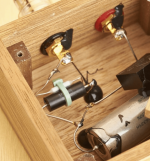Hello evertone.
I am trying a copy of a simple Zobel network and can't seem to identify this component (the small white one in the picture) I assume it is a small value resistor, but I have never seen one like this before? It's secured to an Ohmite WH series 5W resistor. I have all the other components to hand so I am going to breadboard and see how it works at virtually no cost, but would love to know what the stange white component is.
Thanks!
I am trying a copy of a simple Zobel network and can't seem to identify this component (the small white one in the picture) I assume it is a small value resistor, but I have never seen one like this before? It's secured to an Ohmite WH series 5W resistor. I have all the other components to hand so I am going to breadboard and see how it works at virtually no cost, but would love to know what the stange white component is.
Thanks!
Attachments
I did find these and then changed my mind as the ends where they closed over the lead out looked a little differentStyroflex capacitor.
I did find these and then changed my mind as the ends where they closed over the lead out looked a little different
Mooly is right!Could it be a thermal device of some kind for overload protection?
Measure it in circuit. If its a thermal fuse it will read very low resistance.
Strapping it to the resistor which will get hot under high drive conditions also makes sense as the fuse relies on being heated by whatever it is monitoring.
Strapping it to the resistor which will get hot under high drive conditions also makes sense as the fuse relies on being heated by whatever it is monitoring.
But the plastic tie-wrap may fail first, and the wooden enclosure support and spread the ensuing fire... Metal enclosure would keep out hum as well as preventing fire, and the resistor could be a fusible type to simplify things.
Not sure silicone is available that's hard enough for the teeth needed in that sort of tie. Nylon is typically used as its a hard plastic, below it's glass-transition temperature and mainly crystalline. Silicones are well above their glass-transistion temperature and are thus rubbery rather than crystalline. Yes plastics can be crystalline (but in a different way to other materials).
I just looked them up. The silicone zip ties are really more like cable ties than a standard zip tie shown in the picture.
or PEEK https://www.nelcoproducts.com/store/miniature-peek-high-temp-cable-ties-4.html I doubt it get's that hot to be honest. it's 5W rated, so it must expel that amount of heat energy. I guess the temperature of the surface could be calculated to allow that in free air convectionIt may be a silicone zip tie.
The maximum dissipation rating of a resistor is not something you'd routinely use, it will certainly be hot enough to burn skin at that limit, melt plastic and possibly solder if not cooled as per the datasheet footnote (the devil is in the details). Heat-sink mounted resistors are a good choice sometimes 🙂or PEEK https://www.nelcoproducts.com/store/miniature-peek-high-temp-cable-ties-4.html I doubt it get's that hot to be honest. it's 5W rated, so it must expel that amount of heat energy. I guess the temperature of the surface could be calculated to allow that in free air convection
- Home
- Design & Build
- Parts
- Any idea what this part is?
